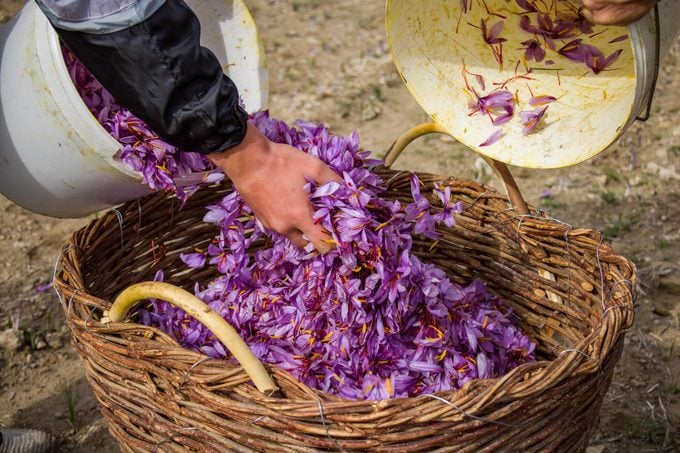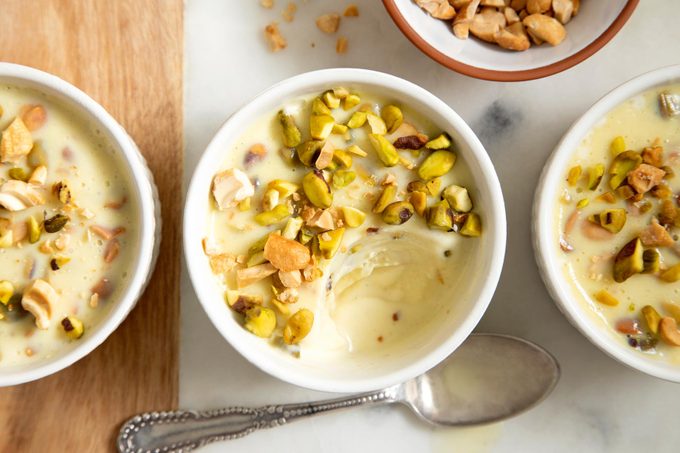What Is Saffron?
Updated: Jan. 03, 2024

Saffron is a treasured spice, known for its goldenrod color and rich, distinct flavor. Here's what to know about the world's most expensive spice.
Saffron is cooking’s golden child, with its deep orange-colored threads bringing a vibrant color and flavor to any dish. It’s also the most expensive spice in the world. By the 16th century, it cost as much as gold and, today, top-quality saffron will run you up to $10,000 a pound.
Cleopatra was said to use saffron in her bathwater, and the spice launched a fourteen-day war in 1374. But what makes saffron so special? And can you cook with it without shelling out your entire grocery budget? (Spoiler alert: you can.)
So, what is saffron?

Saffron is a type of herb made from the saffron crocus, a purple flower that blooms in autumn. The plants are very particular: the flowers only bloom for one to three weeks each year and must be hand-picked.
Why is saffron so expensive?
Producing a single gram of saffron requires roughly 150 flowers and a significant amount of labor. That pushes up the price. Luckily, a gram of saffron goes a very long way. For instance, this shrimp and cod stew in saffron broth calls for only 1/4 teaspoon of saffron threads.
Where is saffron grown?
The saffron crocus can grow almost anywhere in the world, though it loves hot, dry climates. The highest quality saffron comes from the Middle East and Asia—today, most grows in Iran. It’s a common Indian spice, and you’ll also find it in Mediterranean and European cuisine, like Spanish paella or Italian rice dishes. If you like to dabble with different regional dishes, saffron is an essential spice to have on hand.
What does saffron taste like?
Saffron has a blend of grassy and floral flavors, and it adds sweetness and depth to a variety of dishes. Elevate your cooking and complement the use of saffron with other Middle Eastern spices.
What is saffron used for?

Saffron is at the top of its game in rice dishes, but it can be a delicious addition to sweets or even tea. Add it to a hearty meat dish like this rhubarb beef or a dessert like kulfi. Here’s a good rule of thumb: If vanilla is included, saffron will thrive! Even a small amount adds fragrant flavor and a burst of golden color, and it plays well with other spices.
To get the most color and taste, soak the saffron threads in water or broth before cooking for at least thirty minutes, and add the infused liquid right before you serve.
Along with adding complex flavors to a wide variety of dishes, saffron has also been celebrated for its health benefits. In the 14th century, the herb was used as a remedy against the Black Death. Now, researchers say saffron delivers many benefits to your body, improving everything from insomnia to digestive discomfort and immune function.
Editor’s Tip: Avoid using wooden utensils when cooking with saffron, which can absorb some of the flavor.
What is the best saffron substitute?
Luckily, the most popular saffron spice substitute is much less expensive: turmeric. The golden root—a member of the ginger family—can brighten up dishes with a similar vibrant hue and delivers anti-inflammatory and disease-fighting benefits.
Use turmeric more sparingly than saffron, though. Saffron has a subtler flavor, and you want to make sure turmeric’s acrid notes are in perfect proportion to the other flavors in your dish. Iron Chef Geoffrey Zakarian recommends combining 1/4 teaspoon turmeric with 1/2 teaspoon paprika to achieve a taste as close to saffron as possible.




















